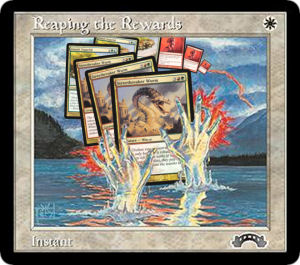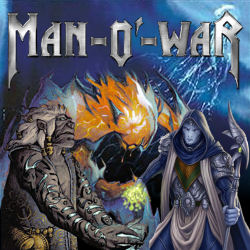Have you ever drafted the same three colors for five drafts in a row? At a Pro Tour?
I have.
Have you ever gone 3-0 with an archetype, only to go 1-2 with an almost identical deck in the following draft?
I have.
Have you ever gone through twelve rounds to get to 10-2, only needing to win the next round and draw into the Top 8… and then failed miserably, going 0-2 over the next two rounds to finish outside the final placings?
I have.
How on Earth did I draft the same colors for 5 drafts in a row, going 3-0 at times and 1-2 at others? Want to know more?
Let’s start from the very beginning…
The Practice
It all started a week before the tournament. I managed to acquire some Dissension packs at the prerelease, and gathered a few friends over to my place to practice. Of course, the Mighty MTGO does not have such convenience at the moment.
At that point, my favorite combinations in RRG draft were U/B/R and U/W/B, as I felt they were the strongest and most dominant – especially U/B/R. I went into the draft practice with the mindset of forcing either archetype.
In the first practice draft, I got some reasonably good removal and card advantage spells in the first two packs, as I went U/B/R hoping to reap some Seals of Fire/Doom or Wrecking Balls in the third pack. However, Dissension was disastrous. I managed to grab a couple of removal spells, but they were the only highlights in the final booster. I began to realize something… Hellbent does not interact well with the nature of UBR archetype.
Dissension offers a lot of reasonably good bodies in Rakdos BR, provided you can achieve Hellbent. Otherwise, most of the time you’re either paying two different colored mana for a vanilla 2/2, or four mana for a 2/2 flyer… and that’s about it.
Once I was done with the draft, I had a hard time solving the puzzle of deck construction. It seemed, at first glance, that I didn’t have a clear direction — everything was a mess. The mana of the deck was horrible, as were the interactions! My brother, Joe, who had the same draft idea as I did, drafted UBR… and he also ended up with a donkey deck.
Obviously, I lost the first round; to Vincent, who drafted U/G/B. He tried to explore the raw power of the Graft Mechanic, concentrating on U/G/x, and he eventually won the first draft. We concluded that UBR is no longer a viable archetype to draft, and we vowed to look into others, since Dissension offers a lot of good UW and UG cards.
Over the next few drafts, I drafted UBW a few times as I thought that the UW cards were underdrafted… I could take advantage of that. Again, my manabase always seems horrible, although I once managed to assemble a fast flying deck with some walls to hold the ground. It sounded pretty good to me… but I was totally wrong.
Again, I played Vincent, who drafted U/G/x in the first draft… and he continued drafting the same archetype. This time, instead of U/G/B he drafted U/G/R. He crushed me once again, I was out-carded and out-tempoed. Vedalken Dismissers, Ogre Savants, Steamcore Weirds… crushing everyone in the room. He won the draft, again.
Still being stubborn, I believed that UBW was the route to go. I drafted it for several more eight-mans, but each time I met Vincent. He was always playing U/G/R or U/G/R/b, and I lost over and over again, without putting up a fight. I felt like a newbie that had just started playing Magic, and I had no idea what was going wrong.
We did five drafts in total, and Vincent made the finals (or won) each and every one.
The night before I left for Prague, I approached him and quizzed him on his drafting strategy:
Terry: I have no idea why I’ve been losing time and time again with U/B/W… I still haven’t found anything good.
Vincent: It’s probably nothing to do with your pick orders. However, when we played I felt my cards quality outclassed yours every time.
Terry: Did you intentionally draft U/G/R all the time? You seemed to be winning and winning.
Vincent: I didn’t do it on purpose. I just saw the cards coming, and I drafted it.
Terry: How do you set and make your pick orders?
Vincent: Well, in the previous draft I first-picked Putrefy, then Carven Caryatid, and there it goes. What more you want to know?
Terry: Erm… just tell me more about it.
Vincent: Let me give you a piece of advice. Follow your heart. Draft the good cards that come to you. “Feeling” is very important in draft, you know… Try not to think about Magic for the next few days. Relax, and you’ll do well at the Pro tour.
Terry: [Feeling like an idiot.] Okay then…
Obviously, Vincent didn’t give any information at all. In fact, he spouted pure garbage that I would happily throw into the trash. His answer was crap… but his strategy worked well, and I had been losing to him time after time. There must be something I’m had missing…
I brainstormed, and tried to remember his style, and thought on decks that he had drafted so far. In those drafts, he’d shout that his deck had nineteen mana sources, and I always saw him with multiple bouncelands. He didn’t play many two-mana creatures (except the really good ones like Guildmages, or Aquastrand Spider). On the early turns, he’d busy himself casting Signets and playing bouncelands, but he’d start laying creatures on turn 3. Pretty soon, the Graft mechanic kicked in. His U/G/R decks seemed similar to the classic triple-Ravnica U/B control/mill strategy: seize of the game. The only difference was that Vincent was controlling the game with quality Graft regenerators, spider effect and flying men, making it hard for the opponent to break the formation. The good old UB controls the board with solid 0/5 walls (Drift of Phantasms), a 1/4 Millstone (Vedalken Entrancer), and the defensive Tattered Drake: U/G/R achieves a similar level of success with its solid Graft guys. From here, I started to formulate my own U/G/R formula, and I tried it at the Pro Tour:
The Pro Tour
1st draft U/G/R

Before we sat down, I’d set my mind on drafting U/G/R if possible, but I vowed to be flexible if good White stuff was passed. In pack 1, my picks were totally crap and out of order. I pick a Green card here, a Blue card there, and some random Red cards. Then, when it comes to the 2nd pack… I began to reap the benefits. I received some awesome Gruul (three Streetbreaker Wurm), alongside a few Izzet tempo cards. In the 3rd pack, I ended up doing even getting better. I was passed three Assault Zeppelids, and I picked up three late copies of Psychotic Fury, which was truly insane in my multicolored creature deck. My deck didn’t have any ridiculous bombs, but the solid commons carried the pod.
In one game, my opponent cast Flame Fusillade twice against me (via Izzet Chronarch) in the same game, but my tempo-oriented deck managed to pound away for damage, with double-striking Wurms predictably winning the game.
Result: 3-0
2nd draft RG/u
I was lucky to crack an Ursapine in the opening pack, passing an obvious Keening Banshee (which I was pretty sure Olivier Ruel would happily take). This meant I would once again be in a good position to receive R/G and U/R cards in Guildpact. One of my notable picks saw me pick up both a Selesnya Signet and a Selesnya Sanctuary, meaning I was able to splash a Congregation at Dawn. This proved to be a potent game-winner. In Guildpact, I opened another bomb rare – Burning Tree Shaman – and gladly to put it in my pile. I was then passed a 3rd pick Savage Twister, showing how light Gruul was drafted on my left side.
I 3-0ed the pod with my super-bomb deck.
Result: 3-0, 6-0
3rd draft U/G/R
I felt pretty good drafting at table 1 after ensuring that I was obviously playing the following day. For the third draft, I decided to stick with my strategy since it had been treating me well so far. You can see the coverage over here.
I took a first pick Vedalken Dismisser to signal Blue, passing both Plague Boiler and Skyknight Legionnaire, in the hope that Justin Gary to my left would pick either one and avoid my beloved Blue. My next pick was complicated: Trophy Hunter, Snapping Drake, or Faith’s Fetters?
Now, obviously the best card in the pack is Faith’s Fetters… but I’m such a stubborn man that I promised myself I’d draft U/G/R if possible (since I 6-0ed with it, and I was improving in playing the archetype with each passing game)… so I took the Trophy Hunter. Then the Oathsworn Giant came along. Then Veteran Armorer. I regretted not taking the Faith’s Fetters, since the person on my right would assume I’d grab it, and thus kept passing good White stuff, but I never appreciate it. As Justin went U/R/W, I don’t get the Izzet hookup in pack 2, and I didn’t finish up with strong Gruul contenders either. Both my Red and Green cards looked shallow and pointless, and my Dissension cards were fairly mediocre (other then a first pick Simic Guildmage). I built a terrible deck, and obviously I got mediocre results.
Result: 1-2, 7-2
Justin’s deck was really good as you can see in the coverage, but somehow Lady Luck is not on his side. He lost to me because he mulliganed once and didn’t get enough lands to operate, and the second game because he didn’t draw many spells. Sometimes, this is our game. It can happen any time, and at all times. We talked a little about the draft, and Justin commented how much he loved drafting U/G/R – since he’s drafted the archetype twice this weekend and 6-0ed his first couple of pods — but in general, he likes to take what comes by. Here’s what Justin said:
“In pack 1 the guilds are pretty much irrelevant. In pack 2 you’re drafting the best guild from Guildpact, and in pack 3 you’re drafting the best guild from Dissension.”
Justin Gary
We joked a little on how unlucky he was to be sitting on my left, since I would never abandon that archetype. I wish him luck in drafting U/G/R in the next pod.
4th draft UG/r/b
I started this draft with the following:
Civic Wayfinder
Civic Wayfinder
Vedalken Dismisser
Mark of Eviction
Watery Grave.
The Watery Grave pick seemed a little odd, but with double Civic Wayfinder in the deck, it really seems wasted if I don’t play with 3 or 4 colors. I figured out I could go with my usual U/G/R, and splash some good removal like Seal of Doom or Wrecking Ball. The 4th pick Mark of Eviction proved to be a good decision, as I won many games by “skillfully” drawing it. I managed to pick up a few good Izzet cards in Guildpact, such as Steamcore Weird and Gelectrode.
In Dissension, I first-picked a Rakdos Ickspitter. It was my intention to splash Black (with the support of Wayfinders and Watery Grave). I followed it up with a Wrecking Ball, and there from there every new card was an auto pick.
I ended up with U/G being my main color pairing. I splashed both Red and Black. The deck worked like a control deck rather then the usual U/G/R beatdown I’d drafted thus far, but it worked pretty well. I always seemed to draw my Mark of Eviction and my “comes into play” 187 guys.
In one game, I was holding on my Mark/Dismisser combo because I knew my opponent (Frank Karsten) had a Douse in Gloom… fortunately, I topdecked a Gather Courage a few turns later. I tapped out and went for the combo, making sure Frank would not draw anymore cards on the next turn, and Frank happily use his Douse. I responded by tapping a Green man to play my Convoke spell. That was the last game to see who went undefeated in the pod.
Result: 3-0, 10-2
5th draft U/G/R
I felt extremely confident, as I could easily make Top8 with a single win and a draw. I was guaranteed if I posted a 2-1. The draft was again covered at MagictheGathering.com, and the only decision I regretted was not picking the Dimir Aqueduct instead of Veteran Armorer. The deck was pretty good overall; it did not looks like a 1-2 deck.
In my match versus Quentin Martin, we both literally threw a game away. His was lost when he didn’t cast a game-winning Incite Hysteria when he has the win on the table, and mine was lost when Quentin called my bluff. Sometimes, it can hurt you just as much as bluff could reward you… so be extremely careful when you are bluffing. You might miss a Pro Tour Top 8 because of it.
In the 2nd game against Shuhei Nakamura (in the following round), I kept a Forest, Signet, Signet, Electrolyze, Snapping Drake, Cleansing Beam, and Assault Zeppelid hand on the play. As long as my first three draw steps get me a land, I’m confident I would be able to get back on the game, since my opening grip is awfully strong. I never draw another land until five turns later, which is far too late. I managed to win the last match, but it didn’t matter.
When you’re in contention all along the Swiss, and only need a mediocre result to make Top 8, and you fail… well, you have no idea how bad it feels. I was clearly disappointed with myself, and blamed myself for some subtle mistakes and poor decisions, but Magic is a game of imperfect information where there is no 100% correct play. Every action leads to other consequences, and the puzzles never stop.
If I’d made Top 8, I would certainly have drafted U/G/R regardless. I don’t care if I open a Hour of Reckoning or a Glare of Subdual (Well, I’d splash the Glare)… I’d force U/G/R, because then I’m playing with the best cards in the format, and it’s simply unfair.
Result : 1-2 , 11-4
I have experimented many times since the PT, and I have a clear picture on how to be successful at RGD draft. Here’s a tip or two:
Mana
Believe me, Prague was the most luck-oriented Pro Tour I’ve ever attended. One quarter of my victory came from manascrewed opponents, either lacking the third color or deluged in excess land. However, you can change this.
In the past, I neglected drafting Signets and bounceland highly, because I thought they were simple fixing and nothing special: I would rather grab a quality spell over a “land”. I was wrong. After I’d lost game after game through mana problems, I knew my strategy required some adjustment. In the PT, there were several times where I 2nd picked a Signet or bounceland, despite the power of the pack. I want every deck to have at least two or three Signets/bounceland (in combination); then I would have confidence in my deck to win the “luck” war.
At times when you lose, you blame it on color screw… but frankly, did you ever think back and wonder if you’d picked that fixing high enough?
Go First
I strongly believe that everyone should opt to go first in this format, mainly because of the bouncelands. This format is not as slow as you think; I know you want to assemble your colors faster by choosing to draw first, but that one card is less valuable compared to the tempo swing you could have by playing first. This is especially true when you play against a totally different archetype. For example, you are U/G/R and your opponent is W/U/B. He wins with fast fliers; you win with a variety of flyers and ground fatties. You don’t want to allow him to drop his fliers first and start the damage race. In such a matchup, it comes down to who starts to deal damage first, as both players will be busy attacking and trying to make the shortest work out of his opponent.
Tempo

I would say this format is tempo-oriented, despite the fact that everyone plays with 3 colors. Why? Vedalken Dismisser, Ogre Savant, and Steamcore Weird. Never once a format had so many “Man-o-War” creatures to choose from, especially as they are all mere commons. In the past, it is more likely you win with good removal spells backed up with quality creatures. Now? You cast a quality critter, I’ll bounce it with Ogre Savant, and attack you with both my 2/2 guys. Cast it again next turn? Okay, I’ll bounce it with another Savant/Dismisser/Repeal (or simply kills it with a removal spell), and I win the game. In fact, a lot of my decks have little access to true removal, but I always used my tempo cards in a way that plays them like true removal. At times, they are even better than true removal because of the tempo swing.
Alright, that’s all I have to say for the moment. I actually feel sick of drafting right now, as I’m pretty sure I would draft U/G/R each and every time. It feels pretty meaningless to draft, as the decks I win with are startlingly similar… but who cares, as long as it’s a winning archetype. Who doesn’t wants to win?
Hey, if you can’t beat em, join em.
Cheers.

